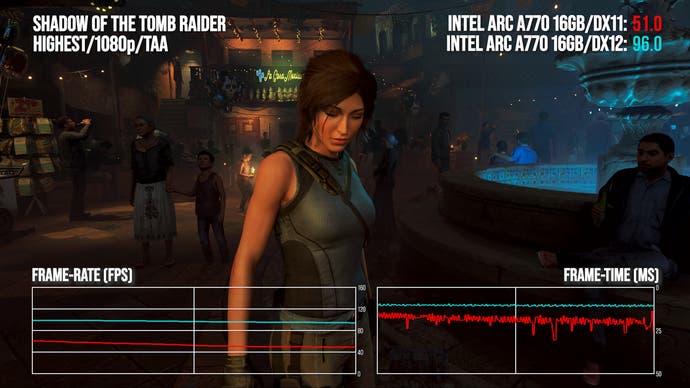Intel Arc A770 and A750: The Digital Foundry Verdict
A promising new architecture, and these cards are already worth buying.
Intel's first proper Arc graphics cards are a pleasant surprise: legitimately good rasterised performance in modern games, oversized RT performance and features that range from novel (Smooth Sync, AV1 encode, DisplayPort 2.0) to vital (XeSS) - all at prices that feel reasonable, a sharp departure from the GPU market of the past few months. Intel is even throwing in some genuinely good-looking upcoming games with either Arc card. Modern Warfare 2 is a big get, alongside Gotham Knights, Ghostbusters: Spirits Unleashed and The Settlers.
We recorded A770 performance generally in the region of the RTX 3060, often better, and sometimes surprisingly close to the RTX 3060 Ti. The lower street price of the RX 6600 XT makes for a harder matchup for the A770, but the Arc card retains a signficant frame-rate lead in RT titles. The A750 is also quite close to the A770, normally recording frame-rates just three to 10 percent behind, although its smaller 8GB of VRAM means that it sometimes faced memory restrictions in our (admittedly maxed-out) benchmarks. In normal use, we expect this to be less of an issue, as you can often reduce texture settings without noticeably affecting visuals.
Having XeSS is a nice feature in the handful of games that support it right now and is likely to become more of an asset as it is integrated by other developers. In RT titles particularly, having this tech on your graphics card is invaluable. However, XeSS remains the newcomer here, with FSR 2.0 supported in a few more games and DLSS remaining the best-supported option by a huge margin.
In terms of content creation, the A750 and A770 join the A380, RTX 4090 and RTX 4080 in the short list of cards with AV1 encoding support. This codec offers significantly better quality at the same bitrate, or the same quality while using less data, so it could be a very nice advantage for video production. Similarly, DisplayPort 2.0 is nice to have, even this particular variety's 8K 60Hz maximum output resolution is matched by DisplayPort 1.4 and its 40Gbps of bandwidth is only marginally higher.



There are still weaknesses here, to be clear. You should not buy an Arc GPU if your PC doesn't support Resizeable BAR, as performance will plummet - to the tune of double-digit percentages. This technology is a nice-to-have on Nvidia and AMD GPUs, boosting frame-rates marginally in some games by allowing the GPU to load data into memory in fewer transfers, but Arc's memory controller is built around having it and really doesn't run well without it. Thankfully, the vast majority of modern motherboards support it, including AMD 400/500/600-series platforms and Intel 400/500/600/700 platforms, although you may have to install a BIOS update if you don't see the Resizeable BAR option in your BIOS. It's worth confirming that ReBAR is active using a tool like GPU-Z too.
Similarly, you can expect significantly lower framerates in older DX9 and DX11 titles. Shadow of the Tomb Raider runs 15 percent faster under DX12 than DX11 in our testing and Control is much the same, but you can also get worse frame health under these older APIs with more frequent stutters and spikes. These can be mitigated to an extent by dropping settings, but if you largely play older titles then Arc may not be for you - yet. Intel has promised driver optimisation will be ongoing, but without a clear roadmap it's hard to see whether we'll see a genuine reversal of the current situation or more modest pitter-patter gains.
These factors make our recommendations fairly straightforward: if you play mostly recently-released games and have a computer built in the last three years, then the Arc A750 and A770 are awesome choices for 1080p gaming at their listed retail prices. These GPUs can stretch to 1440p and even 4K in some titles, and content creators get some unique capabilities to play with too. If you prefer older titles, eg ones that are likely to have built around DirectX 11, or your computer is too old to support Resizeable BAR, then more mature alternatives like the RTX 3060 or RX 6600 XT provide significantly better performance.
For a first try, this is pretty good going. Beyond the surprisingly good frame-rates, the unique mix of features here has been fascinating to explore - and there's plenty here that we didn't touch too, like overclocking. As always, we'd encourage you to check out other outlets publishing Arc A750 and A770 reviews too - this'll give you a sense of performance across a wider spread of games and scenarios than any team can produce alone.
For now, it remains to be seen how Nvidia and AMD will respond to the entrance of a new player in the GPU space. Price cuts on existing models seem likely, but how long will it take before we see new, comparably mainstream GPUs from the red and green teams? One thing's for sure - seeing these results ought to spur on the competition.
Intel Arc A770 and A750 analysis
- Introduction, test rig and hardware
- Gears 5, Shadow of the Tomb Raider, Doom Eternal
- Cyberpunk 2077, Metro Exodus Enhanced Edition
- Red Dead Redemption 2, Control, Forza Horizon 5
- Hitman 3, F1 22
- XeSS testing - Shadow of the Tomb Raider, Hitman 3
- Intel Arc A770 and A750 - the Digital Foundry verdict [this page]
